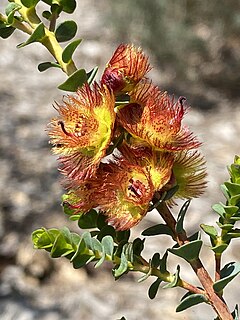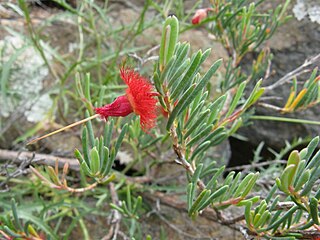Verticordia argentea is a flowering plant in the myrtle family, Myrtaceae and is endemic to the south-west of Western Australia. It is an erect, open shrub with almost circular leaves and scented, pink and white flowers. It usually grows in sand and is found near Eneabba.
Verticordia attenuata is a flowering plant in the myrtle family, Myrtaceae and is endemic to the south-west of Western Australia. It is a shrub with a single main stem, small leaves and pink to purple flowers which fade to white as they age. It usually grows in sand in areas that are wet in winter, often amongst grasses and is found in coastal areas near Bunbury.
Verticordia auriculata is a flowering plant in the myrtle family, Myrtaceae and is endemic to the south-west of Western Australia. It is a small, multi-branched shrub with small leaves and spikes of pink to magenta-coloured flowers in late spring to early summer and it is widespread in the wheatbelt.
Verticordia bifimbriata is a flowering plant in the myrtle family, Myrtaceae and is endemic to the south-west of Western Australia. It is an open shrub with small leaves and spikes of pink flowers.
Verticordia verticordina is a flowering plant in the myrtle family, Myrtaceae and is endemic to a small area near the coast of the south-west of Western Australia. It is a small, low-growing shrub with crowded leaves and in spring, scattered pale greenish-cream and golden brown flowers. Its unusual flowers and fleshy leaves give the plant a superficial resemblance to a Darwinia.

Verticordia fastigiata, commonly known as mouse featherflower, is a flowering plant in the myrtle family, Myrtaceae and is endemic to the south-west of Western Australia. It is a prostrate or low shrub with small, club-shaped leaves and mouse-scented flowers which vary in colour from golden-yellow and orange to dark red.

Verticordia chrysantha, commonly known as yellow featherflower or yellow Morrison, is a flowering plant in the myrtle family, Myrtaceae and is endemic to Western Australia. It is a small, slow-growing, rather bushy shrub with bright yellow flowers which often turn reddish-brown as they age. It is widespread in the south-west of the state.
Verticordia comosa is a flowering plant in the myrtle family, Myrtaceae and is endemic to the south-west of Western Australia. It is an openly branched shrub with small, broad, almost round leaves and spikes of flowers that are pale yellow, sometimes with a white or pale pink centre.
Verticordia coronata is a flowering plant in the myrtle family, Myrtaceae and is endemic to the south-west of Western Australia. It is a small shrub with leaves whose shape depends on their position on the plant, and groups of yellow flowers near the ends of the branches.
Verticordia dasystylis is a flowering plant in the myrtle family, Myrtaceae and is endemic to the south-west of Western Australia. It is a small shrub, with many stems at its base, oblong leaves and scented, fluffy, yellow and white flowers. There are three subspecies, each of which has a priority conservation status.

Verticordia dichroma is a flowering plant in the myrtle family, Myrtaceae and is endemic to the south-west of Western Australia. It is a much-branched shrub with rounded leaves and spikes of scented, deep red and golden-coloured flowers.

Verticordia laciniata is a flowering plant in the myrtle family, Myrtaceae and is endemic to the south-west of Western Australia. It is an openly branched shrub with linear, slightly hairy leaves and heads of scented, bright yellow flowers which turn red then bronze-coloured as they age.

Verticordia lindleyi is a flowering plant in the myrtle family, Myrtaceae and is endemic to the south-west of Western Australia. It is sometimes an openly branched shrub, other times more or less dense, with small leaves and spreading, spike-like groups of pink or purple flowers along the stems in summer, sometimes also in autumn.
Verticordia luteola is a flowering plant in the myrtle family Myrtaceae, and is endemic to the south-west of Western Australia. It is a more or less openly branched shrub with crowded leaves on its side branches and spikes of pale yellow or bright pink flowers which turn cream to brownish as they age. This verticordia is a summer-flowering species.

Verticordia mitchelliana, commonly known as rapier featherflower, is a flowering plant in the myrtle family, Myrtaceae and is endemic to the south-west of Western Australia. It is a shrub with bright red, rapier-like flowers in spring and early summer, which readily distinguish it from other species. It is commonly grown in private gardens and some forms have larger flowers than those usually found in the wild.
Verticordia muelleriana is a flowering plant in the myrtle family, Myrtaceae and is endemic to the south-west of Western Australia. It is an openly branched shrub with relatively large, egg-shaped to circular leaves and long spikes of deep maroon coloured flowers in spring and early summer.
Verticordia multiflora is a flowering plant in the myrtle family, Myrtaceae and is endemic to the south-west of Western Australia. It is a small, openly branched shrub with small leaves and groups of scented, bright yellow flowers on the ends of the branches in spring or early summer.

Verticordia roei, commonly known as Roe's featherflower is a flowering plant in the myrtle family, Myrtaceae and is endemic to the south-west of Western Australia. It is a shrub with narrow leaves and is often covered with masses of creamy-white coloured flowers in late spring.
Verticordia setacea is a flowering plant in the myrtle family, Myrtaceae and is endemic to the south-west of Western Australia. It is a shrub with small leaves and deep pink flowers with short styles in late spring.

Verticordia tumida, commonly known as summer featherflower, is a flowering plant in the myrtle family, Myrtaceae and is endemic to the north-west of Western Australia. It is an open shrub with very small leaves and clusters of deep pink flowers from late spring to early winter.







